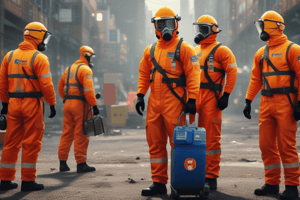Podcast
Questions and Answers
In a high-voltage electrical emergency, what should the first arriving unit do?
In a high-voltage electrical emergency, what should the first arriving unit do?
- Perform a 360 assessment and establish accountability (correct)
- Avoid contact with any wires or objects near the hazard until confirmed de-energized
- Establish a restricted zone large enough to include any area that could become unsafe
- Position apparatus and personnel according to specific responses and procedures
What should be considered energized in a high-voltage electrical emergency?
What should be considered energized in a high-voltage electrical emergency?
- All low wires
- All split wires
- All broken wires
- All down wires (correct)
What should personnel avoid in a high-voltage electrical emergency until confirmed de-energized?
What should personnel avoid in a high-voltage electrical emergency until confirmed de-energized?
- Vehicles
- Trees
- The ground (correct)
- Buildings
What should the Incident Commander do in a high-voltage electrical emergency?
What should the Incident Commander do in a high-voltage electrical emergency?
What should be done with generators and solar panels in a high-voltage electrical emergency?
What should be done with generators and solar panels in a high-voltage electrical emergency?
What should be done before entering a restricted zone in a high-voltage electrical emergency?
What should be done before entering a restricted zone in a high-voltage electrical emergency?
What should the first arriving unit do in a high-voltage electrical emergency?
What should the first arriving unit do in a high-voltage electrical emergency?
What should be done with down, low, broken, frayed, or split wires in a high-voltage electrical emergency?
What should be done with down, low, broken, frayed, or split wires in a high-voltage electrical emergency?
What should be done if the scene in a high-voltage electrical emergency is not confirmed safe by power company personnel?
What should be done if the scene in a high-voltage electrical emergency is not confirmed safe by power company personnel?
What should be done with objects near the hazard in a high-voltage electrical emergency?
What should be done with objects near the hazard in a high-voltage electrical emergency?
Flashcards are hidden until you start studying
Study Notes
- The document provides arrival and on-scene procedures for high-voltage electrical emergencies.
- The first arriving unit should contact the Emergency Communications Center and provide information.
- The Incident Commander should perform a 360 assessment, establish accountability, and contact the ECC for updates and additional resources.
- Apparatus and personnel should be positioned according to specific responses and procedures.
- All down, low, broken, frayed or split wires should be considered energized.
- No scene should be considered safe until confirmed by on-scene power company personnel.
- The restricted zone established by the IC should be large enough to reasonably include any area that could become unsafe.
- Personnel should avoid contact with any wires or objects near the hazard until confirmed de-energized.
- The ground itself may become energized to deadly levels.
- Generators and solar panels have the potential to "back feed" into wires and other utility-related equipment.
Studying That Suits You
Use AI to generate personalized quizzes and flashcards to suit your learning preferences.




